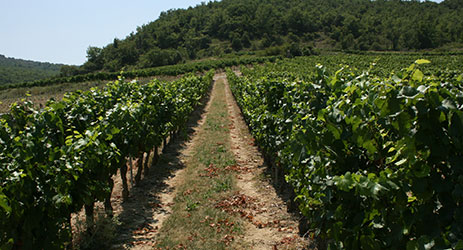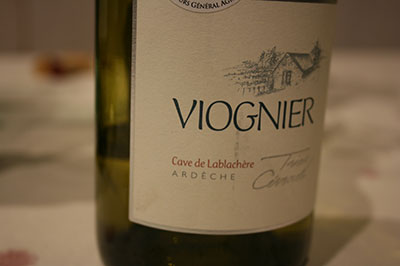Jefford on Monday
This may be the cleverest piece of vineyard sourcing I’ve ever come across, and it led to the creation of one of France’s most enduringly successful Vin de Pays (now IGP) wines. I never met the man responsible for it, Denis Fetzmann, and in 2013 he retired from his long-held post in charge of the domaine holdings of Louis Latour. I recently visited its birthplace, though, and discovered that there’s a new chapter unfolding, of which more later.

The story began in the 1970s; the sixth Louis Latour, frustrated at Burgundy’s inconsistency, asked Fetzmann to try to find a Mâcon-like Chardonnay somewhere in the south of France. It must have been tempting for the young man to head straight for the open, bargain-priced prairies of Hérault and Aude. Fetzmann, though, decided to go … not too far. Just to Alba-la-Romaine, across the Rhône from Montélimar in the southern Ardèche, even though the vineyards were still full of hybrids back then, and few growers had decent Chardonnay to sell. What did he sniff out there?
This is the southern end of the same département where you’ll find St Joseph, Cornas and St Péray. It’s karst country, gorge-incised, white with limestone, set well back from the Rhône itself; warm by latitude, fresh by altitude. As importantly, Fetzmann found a reliable partner for this ambitious project in the local Vignerons Ardéchois co-operative group (UVICA).
The result worked magnificently well, though Latour’s fellow négociants had deep misgivings about the association of a Burgundy label with southern French Chardonnay (which was why Latour felt it had to create a special bottle for this wine). There are two versions, succinctly contrastive: the Ardèche Chardonnay, a near-perfect basic varietal; and the Grand Ardèche, a barrel-fermented parcel selection, using around 25 per cent new wood. I’ve long been a fan of both wines, particularly the latter (which can sew havoc in blind tastings of serious white burgundy) and it remains on fine form – see the tasting notes at the end of this blog.
The secrets? It’s machine-harvested – but into small boxes using specially adapted machines, for less brutal fruit handling. Gravity-pressed without débourbage, ‘for a bit more fat and richness,’ according to the Latour Ardèche technical director Alain Berthon. Lots of wild yeast; a warmer rather than cooler fermentation; full malolactic fermentation; and up to 10 months without racking. Initially the target was 13.5%, but now Latour is looking for 13% and something a little more ‘nervous’. (Just a little but no more: the TA remains under 5 g/l as tartaric, with a pH of 3.5 – all very drinkable). But the real secret, of course, is that this part of Ardèche can grow truly impressive Chardonnay, as the percipient Fetzmann calculated. Louis Latour sells around two million bottles of its Ardèche Chardonnay wines every year.
That, though, is not all. At the same time as visiting Latour, I had a chance to see what else the Vignerons Ardéchois and their independent IGP colleagues were up to.
Those besotted with ‘modest varieties’ will know IGP Ardèche as the place to go looking for reds made from Chatus, an ancient indigenous vine here (notably mentioned by Olivier de Serres, the father of French agronomy, who lived locally). This part of the Ardèche doesn’t strike me as red-wine country (many are grassy, herbaceous and bitter-edged), but Chatus is probably the most interesting – while light, it can have aromatic complexity and a seriousness of flavour hard to find in Merlot, Syrah or even Gamay here. I’m sure we’ll see better in the future.
The Vignerons Ardéchois have had huge success with rosé wines, to their own surprise (and to mine): it’s the biggest selling category for this giant cooperative group (which produced the equivalent of 57 million bottles in 2014). But hey, everyone wants to drink rosé nowadays, and these deeper-than-Provence versions are competently made and attractively priced.

It was when I began tasting the Viogniers, though, that the marks began to fly. The Vignerons Ardéchois have one called Terre d’Eglantier, and the 2014 version is deft, graceful, haunting and moreish: a difficult achievement with this sometimes clumsy grape. There are, too, outstanding versions from a number of other producers, notably the startlingly good 2014 Trias Cevenol Viognier from the Lablachère cooperative (jasmine and citrus-blossom aromas with a saline edge); the 2013 Cuvée Viognier from Domaine du Grangeon (poised, textured and elegant); and the impressively dense and succulent 2013 Que Sa Quo from Benoît Salel and Elise Renaud. In contrast to its peers, this final wine is grown a little further north on granite (not limestone) and stake-trained; Benoît Salel formerly worked with Pierre Gaillard.
Louis Latour, too, produces its own Ardèche Viognier (the 2014 is another bullseye varietal) as well as a version called Duo in which Viognier is co-fermented with Chardonnay (the 2014 is a pleasant wine though I don’t see the point of this blend when the varietal wines themselves are so gastronomically apt).
There are some promising late-harvest Viogniers here too, including the floral and apricotty 2014 Cuvée Mathilde from Domaine Vigier, with aperitif-style sweetness: a marvel at under 10 euros. Chardonnay over-performs in southern Ardèche – but Viognier may eventually prove still more successful (the local Viognier grape price, significantly, has now overtaken that for Chardonnay); it can’t be long before there’s some serious Northern Rhône Viognier investment. If Viognier like this came from aspiring New World locations, it would be winning medals by the armful. Why not an appellation for Viognier and Chardonnay here, too?
2014 Ardèche Chardonnay, IGP, Louis Latour
Fresh, muted yet subtle aromas, with elegant, poised flavours, perfectly weighted in the mouth and leaving it fresh and clean: a benchmark varietal with real class. 88
2013 Grand Ardèche Chardonnay, IGP, Louis Latour
Leesy, soft, stealthy aromas, with a concentrated, sustained palate, sappy balance and satisfying depth, length and structure. 91
2012 Grand Ardèche Chardonnay, IGP, Louis Latour
The extra year in bottle has ripened and teased out the rich, lemony fruit. On the palate, by contrast, this is a little nervier and tangier than usual while retaining all the benchmark elegance of the series. 89
2010 Grand Ardèche Chardonnay, IGP, Louis Latour
There’s a powder-puff perfection to the scented lemon, while the palate seems to be reaching some sort of an apogee, too: pure, long, concentrated and chic. 93
2007 Grand Ardèche Chardonnay, IGP, Louis Latour
Here’s one for those nostalgic about ‘classic’ Meursault, or who like well-aged Blanc de Blancs Champagne: mellow, glowing, full of sweet brioche and nuts and held in place by a twist of lemon peel. Resonant and long: at its peak. 92
2005 Grand Ardèche IGP, Chardonnay, Louis Latour
The butter here is beginning to flirt with fudge; mellow, nutty and open, but probably at its best a couple of years ago. 88
Translated by Nina Fan Feng / 冯帆
All rights reserved by Future plc. No part of this publication may be reproduced, distributed or transmitted in any form or by any means without the prior written permission of Decanter.
Only Official Media Partners (see About us) of DecanterChina.com may republish part of the content from the site without prior permission under strict Terms & Conditions. Contact china@decanter.com to learn about how to become an Official Media Partner of DecanterChina.com.


Comments
Submit